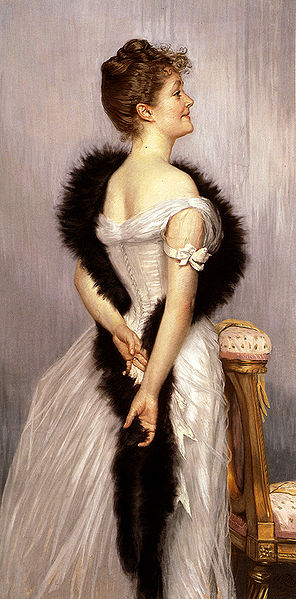The 1880's were a time of subtle fashion changes, where the same basic ideas of the 1870's were looked at in new and creative ways that paved the way for the fashion of the early 20th century. The rigid corseting that had existed for so long in Western fashion had now reached an all-time extreme. The fashionable silhouette was a full bust, a tiny waist, and full hips. The new fitted dresses hid nothing and allowed for no breathing room. Several attempts had been made throughout the 19th century to produce more comfortable clothing, but nothing really stuck until the desired changes were brought about by necessity during World War I.
The bustle had briefly gone out of fashion during the mid-late 1870's, but by the early 1880's, they were back in full force. Some overskirts for both day and evening were pinned up to reveal a matching underskirt.
Sleeves for both day and evening remained basically the same; day dresses had long, fitted sleeves, and the sleeves on evening gowns were short and off the shoulder. However, as I'm researching, I'm also seeing several gowns with elbow length sleeves (as in the above image). My first guess is that they're evening dresses, but they could also be for the afternoon or dinner, with the longer sleeves of day wear but the low necklines of evening wear.
The necklines on day dresses rose from the base of the neck to a high collar, foreshadowing similar looks from the 1890's and 1900's.
The long, jacket-like bodices of the 1870's were still popular for walking dresses. Rouching was also common.
 |
| Source. Also check out the elbow-length sleeves. |
About 1885 and more so as the 1890's drew closer, a strange phenomenon emerged in evening wear. Sleeves on some evening dresses became ridiculously puffed. We're talking 1830's levels of volume. It didn't overwhelm evening gowns exclusively, but it did offer a glimpse of what we'll see as we forge ahead into the Edwardian era.
Silk and silk brocade were both extremely popular fabrics of the period for any time of day.
Hair was worn high on top of the head, with bangs curled over the forehead. Some hats were slightly larger than in the 1870's, with brims that framed the face, while others perched on top of the head and fastened with ribbons under the chin.
As I've been researching this decade, one name keeps coming up over and over again; Charles Frederick Worth. After
Googling researching it, I found out that he's widely considered the father of Haute Couture as we know it today, and he designed clothing for the majority of the Victorian era. Fashion history nerd moment: he designed the white star-spangled gown worn by Empress Elisabeth of Austria in the
portrait painted by (you guessed it) Franz Xaver Winterhalter. His designs are bold and colorful, ranging from gorgeous to outlandish.
Next week is the last decade of the 19th century, as well as the effective end of the Victorian era (although it didn't end officially until 1901). It seems like not so long ago, we were knee-deep in the era of Jane Austen, Lord Byron, and Beau Brummell. Now we're in the time of the Impressionists, Laura Ingalls Wilder, and the soon-to-be king of England Albert Edward. And in just a few short weeks, we'll be halfway into the 20th century, and this leg of Decade Wednesday will be over. Join me next week, when we kiss the 19th century goodbye.
















No comments:
Post a Comment
,mmmmmmmmmmmmmmmmmmmmmmmmmmmmmmmmmmmmmmmmmmmmmmmmmmmmmmmmmmmmmmmmmmmmmmmmmmmmmmmmmmmmmmmmmmmmmmmmmmmmmmmmmmmmmmmmmmmmmmmm'aaaaaaaaaaaakAAAQA
I was going to type something clever, but my cat provided this triumph of literature. Thank you for commenting! Just keep it clean, on-topic, and respectful.